1. Introduction
For many years, credible meteor observers have reported
some shooting stars producing various acoustic noises at the moment they
were appearing.
However, knowing that the speed of sound in our
atmosphere is around 340 meters per second and that fireballs generally
appear at altitudes around 90 km, the sounds associated to the fireballs
should be delayed by several hundreds of seconds.
To explain these anomalous sounds appearing simultaneously
with meteors, Keay (1980) proposed that some ELF/VLF (extremely low frequency
/ very low frequency) electromagnetic energy could be radiated by the decaying
meteor and then transduced into audible sounds at the observer location.
This ELF/VLF high speed vector is supposed to explain the observed simultaneity
of sound and meteor light.
A Global Electrophonic Fireball Survey performed
by Vincovic et al. (2002) suggests that the electrophonic meteors, as Keay
named them, produce a very wide family of hissing, swishing, rustling,
buzzing, whooshing or … crackling sounds.
Keay’s theory states that trapping
and twisting the earth magnetic field lines in the turbulent wake of the
largest meteors and then releasing them suddenly could be the reason for
producing high power ELF/VLF radiation in the 100 Hz to 10 kHz range.
Breech & Foschini (1994) explained that the
Keay’s theory was only able to explain the long duration noises such as
hisses and other high-pitched whistles, but not the pops, tics and
other claps which were often reported. They developed their own “space
charge model” theory which states that some sharp shock waves occurring
in the meteor trail plasma could induce some sudden electrical field transients.
Several tentatives for recording such electrophonic
phenomenons, using microphones, video cameras and VLF receivers were performed
these last decades (see bibliography).
In fact, due to extreme rareness of the electrophonic
phenomenon, instrumentally recorded electrophonic meteor data are very
scarce and not statistically convincing.
The purpose of the present experiment, “Searching
for ELF/VLF meteors signatures” is simply to verify, by means of statistical
analysis of coincidences between radio and meteors events and by spectral
analysis of the candidate VLF radio events, that some meteors entering
the Earth atmosphere are really radiating some detectable ELF/VLF electromagnetic
energy.
2. Experiment
2.1. Principle
The aim of this study is to record in parallel as
many ELF/VLF events and meteor detections as possible, to compare any incident
radio signals (in the 20 Hz-20 kHz range) with any occurrence of meteors
in the radio field of view of the observer, and to determine statistically
if the radio events are significantly correlated with the incoming meteors.
A signature analysis of each radio event related to a particular meteor
is also performed in the frequency and in the time domain, as an attempt
to perform a kind of taxonomy study of the meteor radio signatures, if
any.
To detect as many meteors as possible, the radio
forward scatter method was selected (Rault, 2007), rather than the optical
observation method. Compared to the visual/video meteor observation method,
the forward scatter radio method is offering more opportunities to detect
faint and bright meteors (up to several hundreds radio echoes from sporadic
meteors per hour), and is not subject to disturbances from the Sun and
Moon light or from any masking clouds or fog. A radio meteor detection
system is able to work 24 hours a day, except for the few periods when
an anomalous radio propagation phenomenon occurs, such as Es (apparition
of a sporadic E layer ionized cloud) or in case of tropospheric propagation.
The idea behind this is that by multiplying the number of meteors detections,
the chances should be higher to identify interesting temporal correlations
between the meteor arrivals and the ELF/VLF events.
It has to be noted that the data reduction of such
records is very challenging, because the ELF/VLF spectrum is crowded with
natural and man-made signals. Each coincidence between a radio and a meteor
event has therefore to be processed manually.
2.2. Set-up
As is shown on Figure 1, the observational set-up
is mainly made of:
- a VHF reception chain dedicated to the forward
scatter detection of meteor pings,
- an ELF/VLF sensor,
- a stereo digital recorder.
The equipment was designed to be portable, self
powered and as light as possible. The reason is it has to be run in remote
areas only, i.e. as far as possible from any power lines, cities or railways
which always radiate a lot of hum and various anthropic noises.
The data crunching set-up consists of a laptop
computer fitted with a spectral analysis software which purpose is to process
and to display simultaneously the data coming from the stereo channels.
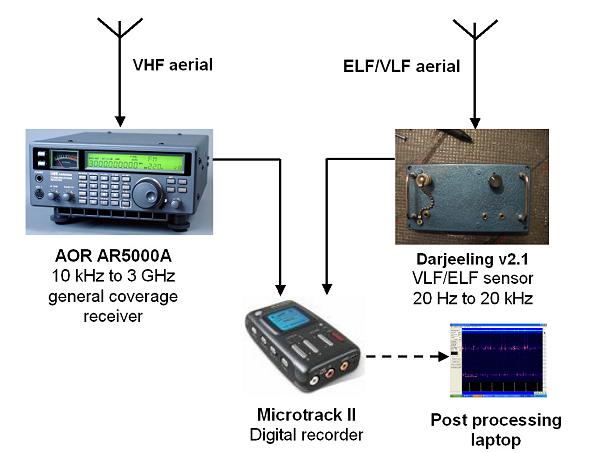
Figure 1 – Instrument configuration
Most of the laptop computers are poor field audio recorders because most of them radiate a lot of various radio noises in the VLF to VHF domain. Furthermore, their embedded audio sound chipset does not generally fit the dynamic and frequency range required for the ELF/VLF records. This is the reason why a good quality digital recorder has to be preferred.
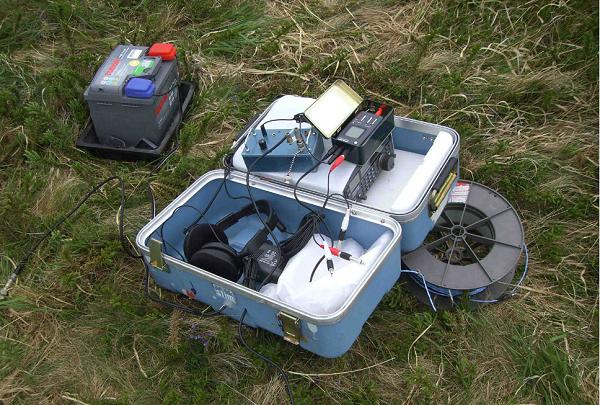
Figure 2 – Actual field installation
The data recorded in the field are stored on Compact
Flash memories which contents can be easily transferred to any computer
for further analysis.
As is shown on Figure 2, the portable equipment
is protected by a watertight container and powered by a 12 V car battery.
This portable recording system design is presently
subject to variations and permanent improvements. The current configuration
(june 2009) consists of:
- a VHF antenna (50 MHz dipole or 4 elements Yagi
143 MHz beam, depending on the forward scatter transmitter to be used),
- an AOR AR5000A general coverage receiver (10
kHz to 3 GHz, all modes) dedicated to the meteor pings reception, but also
occasionally used to receive some time stamps from several VLF or short
wave time signals transmitters,
- an ELF/VLF cylindrical antenna,
- a home-brew ELF/VLF receiver,
- a M-Audio Microtrack II digital recorder fitted
with a exchangeable 8Gb Compact Flash memory card,
- a 12 V/ 54A.h car battery giving a recording
autonomy of more than 48 hours,
- a 12V/5V DC/DC converter used to enhance the
autonomy of the internal battery of the digital recorder,
- several ancillaries such as a 12V LED light,
a set of headphones, a batch of various cables, a laptop computer to control
the records in the field and a “survival toolkit” including various tools,
spare parts and a 12V DC soldering iron.
The specification requirements for the ELF/VLF reception
chain were as follow:
- as low as possible cut-off frequency
- high dynamic range
- low distortion
- light weight
- low cost
- low power consumption.
-
The frequency response of the Microtrack
II recorder (20 Hz to 20 kHz +/- 0.3dB) and its dynamic range (101 dB at
48 kHz sample rate with 24 bits words) were used as metrics for the development
of the associated ELF/VLF antenna and receiver.
The antenna (specially designed for this experiment)
is a one meter long metallic cylinder and its diameter is 50 mm, which
gives a capacitance of about 29 pF allowing good performances even in the
ELF part of the radio spectrum.
It consists of a rectangular piece of wire mesh
wrapped around a plastic foam cylinder. Such a vibrations dampening device
was preferred to the usual thin and rigid whip aerial for two main reasons:
- it is less sensitive to the mechanical vibrations
provoked by the strong winds which can be faced in the field,
- the capacitance of such a large diameter antenna
is higher than the one of a thin whip, improving therefore the low cut-off
frequency of the reception chain.
Such a low series capacitance antenna implies the
use of a very high input impedance amplifier.
A FET/BJT (Field Effect Transistor / Bipolar Junction
Transistor) cascode front end design was selected, because of his intrinsic
qualities, such as high input impedance, low noise, low distortion and
high dynamic range.
The detailed diagram of the ELF/VLF receiver is
shown on Figure 3. Its simulated band pass is shown on Figure 4.
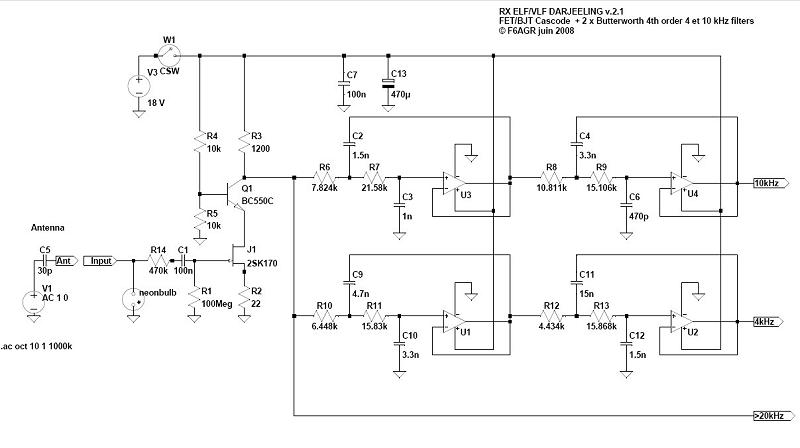
Figure 3 – Drawing of the ELF/VLF
receiver (click on the picture to see the full size image)
The 2SK170 FET and BC550C BJT transistors were selected
owing to their good performances in the noise, dynamic range and distortion
domains. The gate of the FET transistor is grounded thanks to a 100 megohms
resistance made of ten 10 megohms low noise metallic film resistors wired
in series. This very high value resistance is mandatory to keep the low
cut-off frequency performance of the whole reception chain as low as possible.
The 470 kilohms R14 resistor, which is not mandatory
is used to protect the receiver against any high level RF fields which
could be received from nearby or powerful broadcast transmitters, if any.
R14 can be removed if the receiver is to be used in radioelectrically quiet
places.

Figure 4 – Simulated bandwidth of
the entire ELF/VLF reception chain (aerial, front end and switchable Butterworth
filters)
The front end stage is followed by two selectable
low pass filters. Each of them consists of a classical 4th order Butterworth
filter presenting a theoretical roll-off rate of 80 dB per decade
The first filter is a 4 kHz low pass filter, the
second one is a 10 kHz filter.
To obtain good filtering performances, it is important
to respect as much as possible the values of the R and C components constituting
the Butterworth filters. This can be achieved by using series or parallel
combinations of resistors chosen in the 1% tolerance family.
A low capacitance coaxial cable, which length has
to be as short as possible, must to be used to connect the antenna to the
receiver input. The model of cable which is used for car radio antennas
has to be preferred for the present experiment. Its lineic capacitance
is about 37 pF/m, instead of 100 pf/m which is a typical value observed
on most of the usual 50 ohms coaxial cables.
The preliminary tests of the ELF-VLF chain fitted
with its 1m large diameter vertical antenna confirm the good behavior of
the system in the lower part of the radio spectrum (see figures 5 and 6).
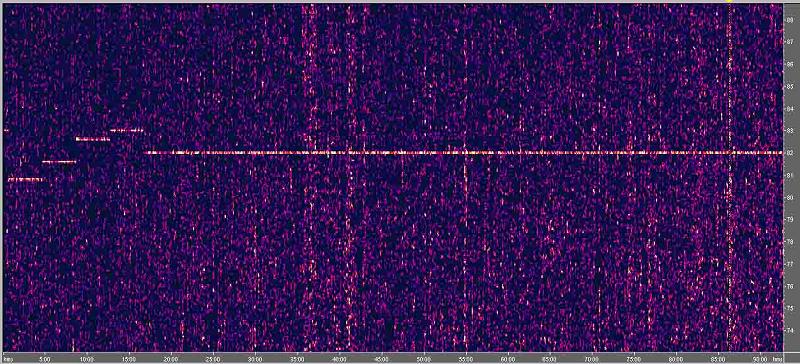
Figure 5 – ZEVS transmitter
received on 82 Hz in Britanny
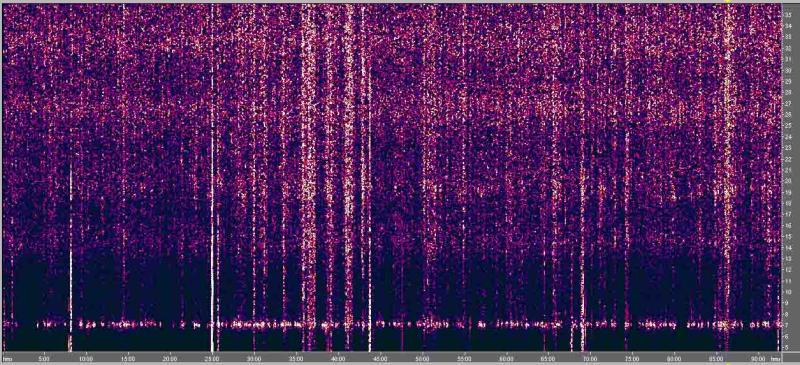
Figure 6 – Schumann resonances detected
in Corrèze
2.3. Observation location
Choosing the right observation place is a delicate
task. The quality of the ELF/VLF data is subject to two main conditions:
- avoiding the presence of any objects (tree, bush,
car, building, pole, etc.) or people in the vicinity of the antenna, because
they all deeply attenuate the incoming signals,
- locating the system as far as possible
(i.e. some kilometers if possible) from any power lines or buildings which
always radiate a huge amount of hum, mains harmonics and various spikes.
2.4. Taxonomy of the events signatures
2.4.1. Events representation
The analysis of the signatures of the VHF meteor
pings, of the ELF/VLF signals and of their potential coincidence
is performed by looking at the events signatures in the frequency and in
the time domain, and by listening to them thanks to a stereo headset.
For this purpose, a free Digital Audio Editor such
as Audacity , or a more powerful but more complex Signal Analysis Toolkit
such as Spectrum Lab are perfectly suitable.
2.4.2. Meteor echoes signatures
The VHF pings are radio echoes coming from a distant
transmitter illuminating the meteors (or more precisely, illuminating the
meteor ionized trails and/or the plasma surrounding the meteoroids themselves).
The actual echo radio frequency (around 50 or 143 MHz) is translated by
the VHF receiver into audio frequencies (20 Hz to 20 kHz) which can be
easily perceived by the human ear and processed thanks to a common
PC sound card. A frequency analysis of the incoming meteor echoes is the
most suitable tool to study the meteor pings, because it gives details
on the radial speed of the meteor and/or its trail.
2.4.3. Meteor ELF/VLF signatures
Potential meteor signatures have to be selected
with a great care. The criteria for deciding an ELF/VLF event was
potentially produced by a meteor was to select only uncommon low frequency
signatures, i.e. signatures different from the well known sferics, tweeks,
whistlers or local thunderbolts discharges.
3. Results
A 143 MHz transmitter was used for the Perseids
2009 campaign.
More than 20 hours of VLF and VHF radio observations,
i.e. about 20Gb of data were recorded during the pre-Perseids 2009 (the
6th of august in Brittany) and the Perseids 2009 (the 11th and the
12th of august in Corrèze).
Ten hours ten minutes of data records were carefully
analyzed, mainly during the first and second burst (i.e. around 8 AM and
6 PM UTC) of the Perseids but not during the third burst at 6 AM UTC on
the 13th of august which was not recorded).
During these 610 minutes, 500 meteors have been
detected thanks to the French Graves VHF military radar (see figure 7)
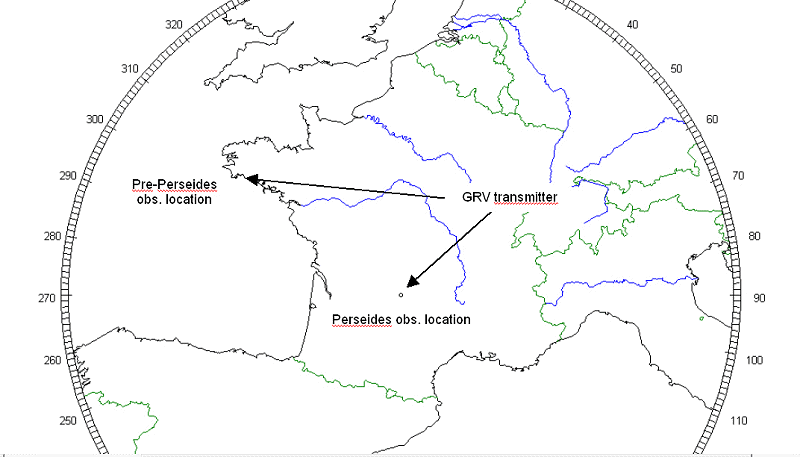
Figure 7 – Perseids 2009 observation
locations
For these 500 meteors, 174 coincidences were observed
with ELF/VLF events, which gives 35% of candidate meteors radiating some
very low frequency electromagnetic energy when entering the Earth atmosphere.
The following criteria were used to decide if an
ELF/VLF event was a good meteor candidate:
- the time lag between a VHF meteor detection and
a possibly related ELF/VLF event had to be less than 500 ms,
- The signature of the associated ELF/VLF event
had to be of unusual amplitude or shape compared to the well known common
natural noises signatures.
Some examples of remarkable coincidences are shown
on figures 8 to 13.
A tentative VLF/VHF observations campaign was performed
one year ago with the help of Renato Romero. The live VLF data received
in Cumiana, Italy by Renato were retrieved from Internet and compared
to the VHF meteor pings detected near Paris, France. However, there was
an unpredictable jittering delay on the VLF live data received from Internet,
and no useful correlations were therefore possible. In another attempt,
Renato recorded VLF data on DVDs and sent them to me. However, time synchronisation
issues occurred again, because the sample frequency used by Renato was
never exactly the same as the one produced by my own computer, so again
the VLF/VHF correlations task wasn't possible.
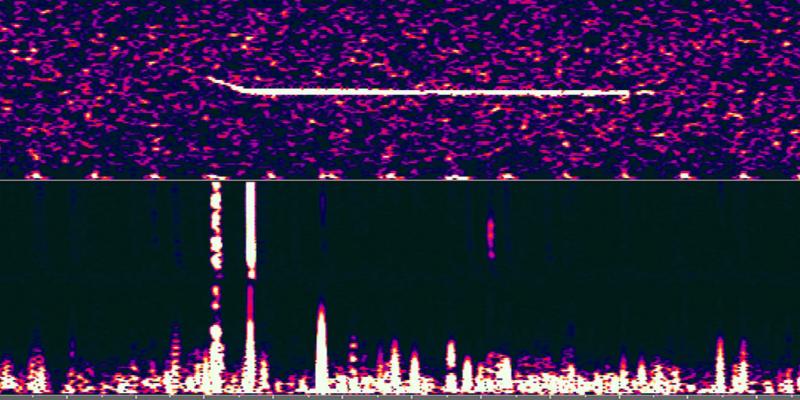
Figure 8 – VLF spikes during a meteor
head echo (frequency domain)
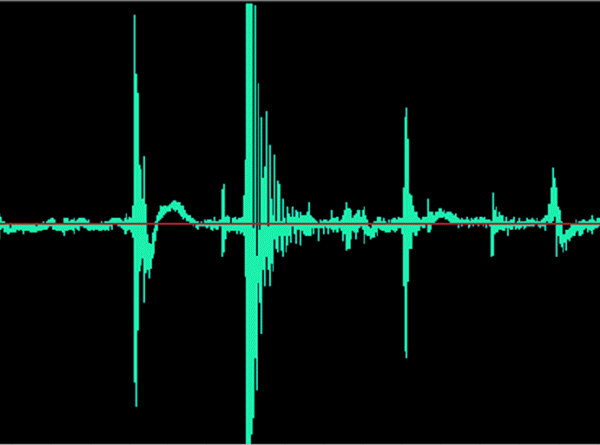
Figure 9 – Same VLF spikes but seen
in the time domain
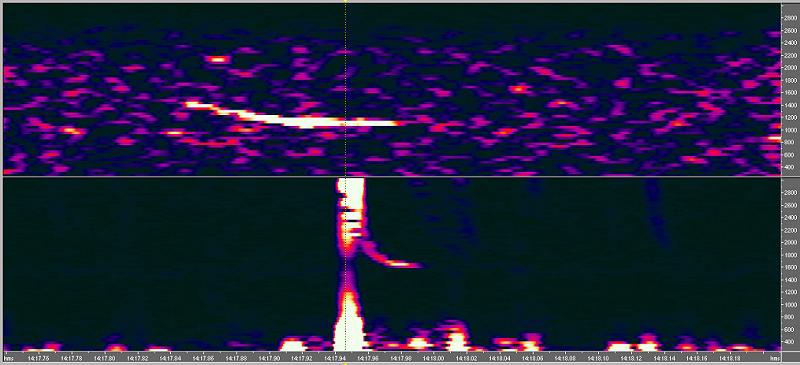
Figure 10 – ELF tweek associated
to a VHF meteor ping
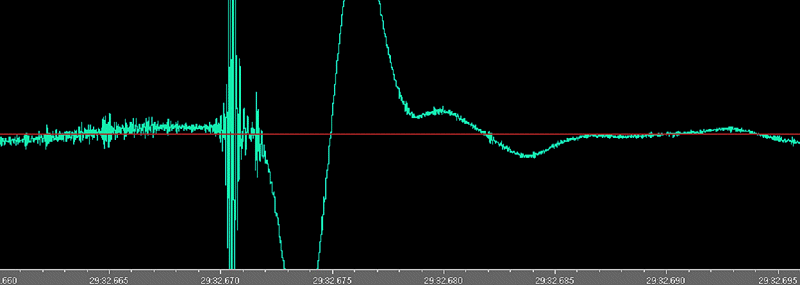
Figure 11 – Time domain representation
of a very large ELF spike associated with a meteor ping
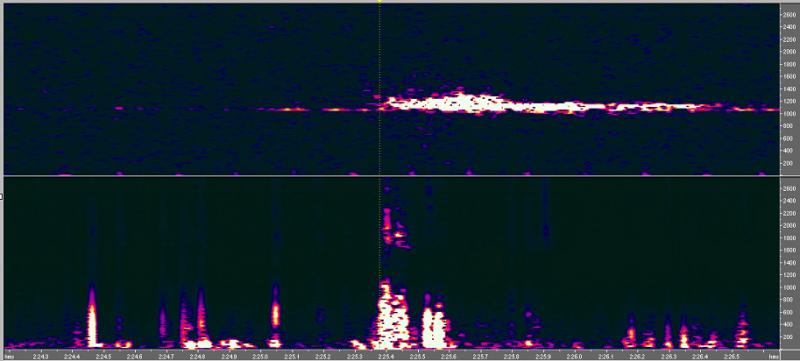
Figure 12 – Burst VLF spikes associated
with the beginning of a turbulent meteor trail
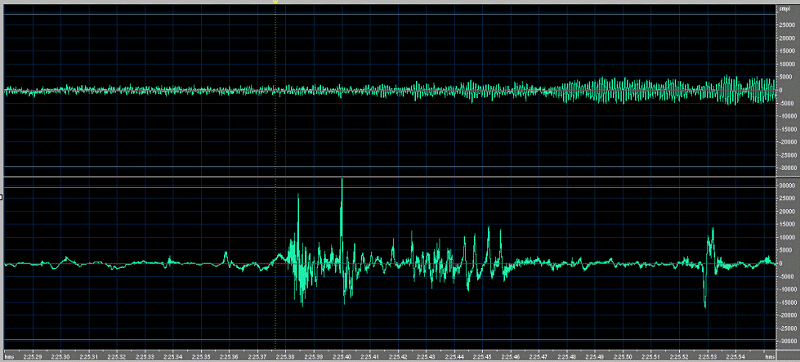
Figure 13 – Time domain representation
of the above VLF burst
All these examples were selected for this paper
because they look representative of interesting ELF/VLF meteor candidates,
their low frequency radio signatures being clearly different from the usual
natural noises.
It is to be noted that almost all of the detected
ELF/VLF meteor events occurred during the decaying phase of the meteoroids,
and not during the trail echo phase.
This is tending to prove that the radio frequency
radiations, if any, occur mainly during the ablation phase of the meteors
and are not generated by any persistent trail plasma phenomenon.
No long duration ELF/VLF events signals at all
were detected during this study. All of them belong to the short duration
/ spike category
Figure 11 is an example of an unusually large long-tailed
spike (thirty four similar ELF spikes were identified during this study).
Figure 13 shows a burst consisting of some uncommon saw tooth spikes which
period is around 4 ms.
A good knowledge about the VHF echoes signatures
and the ELF/VLF events shapes is mandatory for correctly identify
the potential candidate samples.
4. Discussion
Looking for correlations between meteors and ELF/VLF
events is a very demanding and a very time consuming task. The detection
of the interesting events can't be automated, because the ELF/VLF events
signatures are not known in advance.
More details on this study and on the results are
given in (Rault, 2009).
5. Conclusion
The theories stating that some meteors can radiate
low frequency electromagnetic energy seem to be supported by the present
practical study which is based on hundreds of actual discrete observations
of meteors and ELF/VLF events.
However, more data are still needed to confirm
such a conclusion. The next most important meteor showers should be a good
opportunity to collect more interesting correlations .
Acknowledgements
Thanks a lot to Renato Romero for his various tries to furnish VLF data in different ways for this present correlation study.
Bibliography
Beech M., Brown P., Jones J. (1995). “VLF detection
of fireballs”. Earth Moon and Planets 68: 181–188.
Beech M., Foschini L. (1999). “A space charge model for electrophonic bursters”. Astron. Astrophys.345, L27-L31
Cummer S.A. (1997).”Lightning and remote ionospheric sensing using VLF/ELF radio atmospherics”. Stanford University thesis.
Delcourt J.J. (2003).” Ionosphère : région
D, sondage passif et propagation des signaux LF et VLF”. Hermes Science
Publications. ISBN 978-2746206564
Drobnock G.J. (2001). “Meteors producing VLF signatures independent from producing electrophonic sounds”. WGN 29:1, 45-50.
Drobnock G.J. (2002). “VLF signatures from non-fireball meteors – Observations from the 2001 Leonid shower”. WGN 30:5, 152-156.
Garaj S., Vinkovi? D., Zgrabli? G., Kova?i? D.,
Grade?ak S., Biliškov N., Grbac N., Andrei? Ž., (2000). “Observational
detection of meteor-produced VLF electromagnetic radiation”. Fizika A (Zagreb)
8 (1999) 3, 91-98
Guha A., De B.K. , Roy R., (2008), “Possible detection
of GEMINID 2007 meteor shower during day-time from VLF Radiation Spectra”.
Earth Moon and Planets, april 2009.
Keay C.S.L., (1980). “Anomalous sounds from the entry of meteor fireballs”. Science 210, 11-15
Keay C.S.L., (1991). “Meteor fireball sounds identified”. Asteroids, Comets, Meteors 1991, 297-30
Keay C.S.L., (1994). “Audible fireballs and geophysical electrophonics”. Proceedings ASA 1994, 11 (1) 12-15.
Price C., Blum M. (2000). “ELF/VLF radiation produced by the 1999 Leonids meteors”. Earth Moon and Planets 82–83: 545–554.
Rault J.L. (2003). "A la découverte des fréquences basses". Radio-REF, january and march 2003.
Rault J.L. (2005). " Lightning scatter: a faint and rare mode of propagation". VHF Communications 2/2005
Rault J.L. (2007). “ Radio observation of meteors – Leonids as an example”. Observations & Travaux, vol. 65, 1-8.
Rault J.L. (2009) " Searching for meteor ELF /VLF signatures". WGN 37:6 (under publication)
Trautner R., Koschny D., Witasse O., Zender J., Knöfel A. (2002)“ULF-VLF electric field measurements during the 2001 Leonid storm”. Proceedings of Asteroids, Comets, Meteors - ACM 2002, 161-164.
Vinkovi? D., Garaj, S., Lim P.L., Kova?i? D., Zgrabli? G., Andrei? Ž. (2002). “Global electrophonic fireball survey: a review of witness reports – I”. WGN 30:6, 244-257.
Return to the index of www.vlf.it